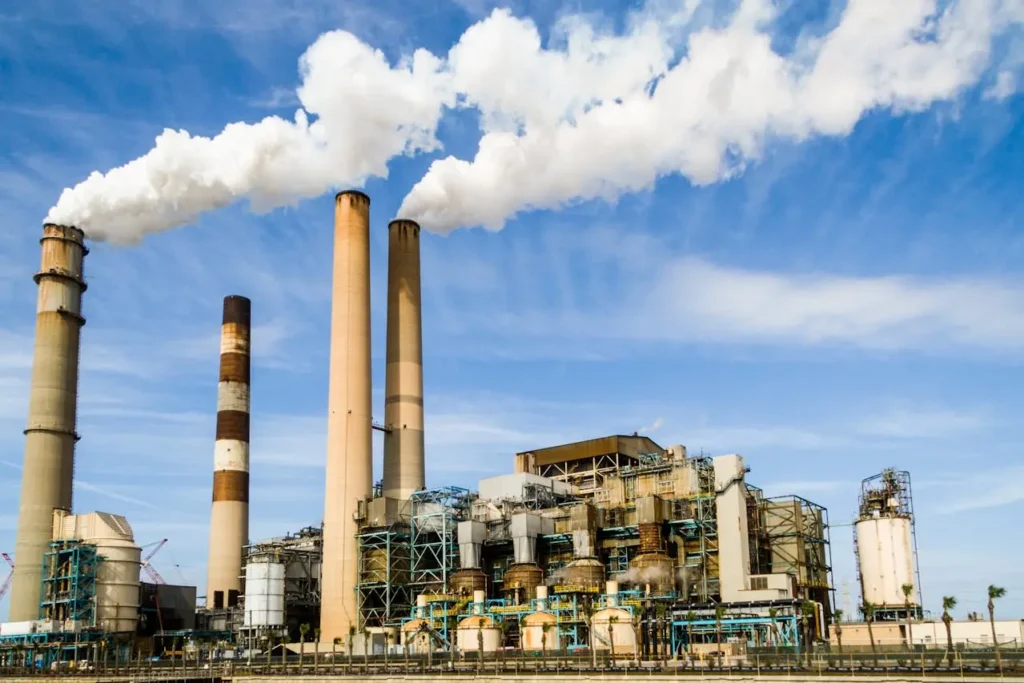
What is industrial decarbonization?
Industrial decarbonization refers to the set of actions aimed at reducing greenhouse gas (GHG) emissions generated by industrial activities. it is based on different strategies such as the adoption of renewable energies, improving energy efficiency, and integrating innovative technologies with carbon capture and storage. this process is essential to transform current industrial models into more sustainable systems, aligned with international climate goals, such as those of the paris agreement.
In france, the national low-carbon strategy (SNBC) sets a clear framework for achieving carbon neutrality by 2050. it establishes sectoral carbon budgets, with specific emission reduction targets for industry, which must reduce its emissions by more than 80% compared to 2015. in belgium, the national energy-climate plan (PNEC) also provides for a significant reduction in industrial emissions, with specific regional implementations in wallonia, flanders, and brussels. these national plans are part of the european green deal commitments, aimed at reducing the eu’s net emissions by at least 55% by 2030. national targets therefore play a driving role in structuring decarbonization efforts.
Why is industrial decarbonization crucial?
Industry’s contribution to global warming
Industry is one of the main sources of greenhouse gas emissions, representing approximately 30% of global emissions. these emissions come mainly from the consumption of fossil fuels to power industrial processes and from the production of materials such as cement, steel and chemicals. inefficient management of industrial waste also contributes to the increase in emissions.
Regulatory and economic requirements
Industries are facing increasing pressure to reduce their carbon emissions. international regulations, such as the paris agreement or the european CSRD directive, impose strict decarbonization targets and reporting obligations. on the economic front, fluctuations in fossil fuel prices and the introduction of carbon taxes are incentivizing companies to adopt more sustainable practices. finally, consumers and investors are increasingly favoring players engaged in low-carbon strategies, thus reinforcing the need for companies to adapt in order to remain competitive and attractive.
Benefits for companies
Decarbonization offers many benefits for companies. it allows them to reduce energy costs by optimizing process efficiency and adopting renewable energies. in addition, it improves brand image, meeting the expectations of consumers and investors. finally, this transition to a low-carbon model also opens up new opportunities, such as access to green markets and the development of sustainable products.
What support is available in france and belgium for decarbonization?
To support the transition to a low-carbon industry, numerous financial and technical assistance schemes are available in france and belgium. in france, ADEME (the french agency for ecological transition) offers several calls for projects, including decarbonization of industry and springboard for the ecological transition, which support investments in energy efficiency, carbon capture, and renewable energy production. the heat fund and the CEE (energy savings certificates) scheme complement this support by financing efficient equipment.
In belgium, the regions play a key role in the decarbonization of industry. in wallonia, industrial companies can benefit from the UDE (sustainable use of energy) scheme, which offers incentives for improving energy performance. in flanders, the flemish energy and climate agency (VEKA) supports decarbonization projects through specific subsidies and personalized advice. in brussels, the ecodyn program encourages companies to adopt proactive environmental management.
In both countries, this support aims to reduce the cost of necessary investments while accelerating the ecological transition of the industrial sector. it constitutes an important lever for initiating or strengthening an effective decarbonization strategy.
Your free carbon footprint is waiting for you!
Sign up for our free trial, answer 20 questions, and receive your 1st carbon footprint!
Strategies to decarbonize industry
Transition to renewable energy
The transition to renewable energy is one of the pillars of industrial decarbonization. it involves replacing fossil fuels, such as coal, natural gas, or fuel oil, with low-carbon energy sources such as solar photovoltaic, wind power, biomass, and green hydrogen. this energy transformation drastically reduces co₂ emissions while improving companies’ resilience to fluctuations in fossil fuel markets and geopolitical issues.
For industries, this can involve purchasing green electricity through long-term supply contracts (PPAs) or installing decentralized energy production systems on-site (solar panels, small wind turbines, biomass boilers). these systems promote energy self-sufficiency, reduce dependence on traditional grids, and strengthen the company’s sustainable image. combined with intelligent consumption management, this transition contributes to building a cleaner, more innovative industry that meets carbon neutrality objectives.
Energy efficiency in processes
Improving the energy efficiency of industrial processes is a key strategy for reducing greenhouse gas emissions while achieving substantial savings. it aims to consume less energy for the same level of production by optimizing each link in the industrial process. this method involves replacing obsolete machinery with more efficient equipment, installing high-efficiency motors, improving thermal insulation, and integrating automated control systems.
Fat heat recovery, i.e., the recovery of heat lost during processes, also helps reduce the overall energy demand of a site. these actions, often hidden from view but highly effective, enable companies to gain competitiveness while limiting their carbon footprint. furthermore, public aid and financing schemes exist to encourage this type of investment, making it a strategic, accessible, and profitable lever for accelerating the low-carbon transition.
Circular economy and recycling
The circular economy and recycling offer concrete opportunities for reducing the carbon footprint of industrial activities. unlike the traditional linear model of “extract, produce, consume, discard,” the circular economy is based on a logic of preserving and recovering resources at each stage of the life cycle. this approach involves rethinking product design to make them more durable, disassemblable, and repairable, as well as incorporating more recycled raw materials into production.
Recycling production waste limits the need for virgin resources and avoids emissions related to their extraction and processing. practices such as eco-design, the pooling of flows between companies (in the form of industrial symbioses), or the sale of closed-loop products reinforce this dynamic. by promoting more responsible management of materials, the circular economy thus constitutes a major lever for reducing indirect greenhouse gas emissions (scope 3) and strengthening the overall sustainability of industrial value chains.
How to decarbonize your company ?
Enter your email address and access immediately our 30-minute webinar. discover our experts' strategic advice for decarbonizing your business.
Raw material substitution
Decarbonizing industry also requires rethinking the raw materials used, particularly in high-emission sectors such as construction, chemicals, and metallurgy. many traditional raw materials, such as clinker in cement manufacturing or certain chemical solvents, have a high carbon footprint due to their energy-intensive production or co₂-emitting chemical reactions.
To limit their impact, manufacturers can use low-carbon alternatives. in the construction industry, this means using “low-carbon” cements incorporating additives such as fly ash, blast furnace slag, or geopolymers. in the chemicals and plastics industries, the use of bio-sourced materials (derived from biomass) makes it possible to replace fossil fuels while incorporating a circular approach. these substitutions not only reduce direct emissions but also strengthen the resilience of sectors in the face of environmental and regulatory challenges.
Electrification of industrial processes
The electrification of industrial processes represents a strategic option for easing dependence on fossil fuels. many industries still use coal, fuel oil, or natural gas to generate heat and power furnaces or boilers. replacing these sources with electrically powered equipment can significantly reduce co₂ emissions, provided that this electricity comes from carbon-free sources (nuclear, solar, wind, hydroelectric).
This transition is particularly relevant in sectors where process heat is below 200°c, such as in the food, light chemical, or pharmaceutical industries. technologies such as industrial heat pumps, electric boilers, and induction furnaces are thus gaining popularity. electrification can also improve energy flexibility and security of supply. however, it must be accompanied by careful consideration of peak consumption management and adapting electricity grids to avoid saturation.
Industrial synergies and energy pooling
Optimizing energy across an industrial region requires the establishment of synergies between companies, also known as industrial ecology. this concept involves organizing the exchange of energy, material, or water flows between several industrial sites to maximize their recovery. a typical example is the recovery of waste heat (residual heat produced by one site) to supply a district heating network or another neighboring industrial site.
This type of pooling makes it possible to collectively reduce co₂ emissions, energy losses, and operating costs. industrial eco-parks such as those in dunkirk and kalundborg (denmark) are already demonstrating the effectiveness of this model. these synergies require strong coordination between local stakeholders, appropriate territorial planning, and sometimes joint investments. in the long term, they strengthen the competitiveness of the industrial sector while fostering a more resilient and sustainable local economy.
Digitization and smart energy management
The digitization of industrial facilities opens up new perspectives for decarbonization by enabling much more precise and responsive energy management. thanks to the installation of smart sensors, smart meters, and energy management systems (EMS), companies can monitor their energy consumption in real time, detect waste, and optimize the performance of their equipment. artificial intelligence even makes it possible to anticipate consumption peaks, adjust production schedules based on green electricity availability, or identify malfunctions invisible to the human eye.
By combining these tools with visualization and management platforms and carbon footprint software like d-carbonize, manufacturers gain efficiency, traceability, and flexibility. thus, digitization is becoming an essential lever in the transition to a low-carbon industry. it is also accompanied by a certification process (iso 50001, for example), which strengthens the credibility of companies’ energy commitments with stakeholders.
Technological innovation
Technological innovation includes the development and adoption of low-carbon technologies, such as green hydrogen, carbon capture and storage processes, or digital solutions to optimize industrial processes. artificial intelligence and smart sensors also make it possible to better monitor and reduce energy consumption. these technological advances make it possible to reduce greenhouse gas emissions, but also to improve the competitiveness of companies in the face of climate and economic challenges.
The industrial sectors most affected by decarbonization
The industrial sectors most affected by decarbonization are those with high energy intensity and high greenhouse gas emissions. heavy industry, particularly steel, chemicals and cement, plays a central role due to its polluting processes. the manufacturing, agri-food and textile production sectors are also targeted for their environmental impact.
What are the challenges to decarbonizing industry?
Decarbonizing industry represents a major challenge for the ecological transition, but it faces several technical, economic, regulatory, and organizational obstacles. one of the first challenges is the cost of investment. adapting or replacing equipment, integrating new technologies, or producing renewable energy locally requires significant financial resources, which are sometimes difficult for small and medium-sized enterprises to access.
On the technical level, some industrial processes still rely on technologies that are difficult to replace without losing efficiency or quality. this is particularly the case in sectors such as steelmaking and heavy chemicals, where low-carbon alternatives are still under development or are not yet sufficiently mature on a large scale.
Regulatory complexity is also an obstacle: standards evolve rapidly, and companies sometimes struggle to keep up with or anticipate new requirements, particularly when operating internationally. furthermore, a lack of internal expertise in energy transition or carbon management can slow the implementation of decarbonization projects.
Finally, some organizational and cultural resistance remains. transforming established models, reviewing value chains, training teams, or changing production habits requires time, support, and a genuine commitment to transformation at all levels of the company.
To meet these challenges, it is essential to combine public support, technological innovation, inter-company collaboration, and team skills development. only under these conditions can the decarbonization of industry be part of a sustainable and competitive dynamic.





